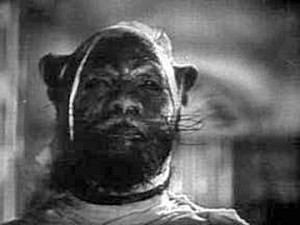 Transparent Men, Human Flies, and Terror Kitties
Transparent Men, Human Flies, and Terror Kitties
We’re playing a double-header today consisting of two very obscure 1950’s SF movies: The Transparent Man Vs. The Human Fly and Terror Is A Man. Both are entertaining, if flawed, though not fatally.
First up, The Transparent Man Vs. The Human Fly, or as it is more commonly known, The Invisible Man Vs. The Human Fly. I prefer the former title. It has more panache.
This 1957 Japanese production is so obscure that it has only 17 votes (one of them mine) on IMBD.com. I’ve been looking for it for a long time because it was, as far as I know, the last Japanese SF film from the 1950’s that I hadn’t seen. Thanks to the fine folks at Sinister Cinema (you should check them out for all your sinister cinema needs), it now has an English sub-titled DVD release. The basic story line is that a rich Japanese businessman has (exactly how may be a detail I either missed or was never explicated; the biggest problem with this film is that the screenplay needed more explications of a complicated series of events) a chemical which can shrink a man to the size of a fly. He hires a psychotic killer (who also apparently becomes addicted to the substance) to commit a series of increasingly bizarre murders as vengeance against a group of men who tried to frame the businessman for war crimes. The murders escalate as the killer also seeks personal revenge.
The movie thus starts out as a police procedural as a detective tries to find the murderer. The only clue at first is a strange buzzing sound heard by witnesses who come upon the varius murder scenes shortly after the murders. As it turns out, the cop is best friends with a scientist who’s been working upon a ray that can turn people invisible. He becomes drawn into the case as his sensei and lab assistant both are murdered as the rich businessman tries to add the invisibility ray to his arsenal of super-scientific weapons.
The plot becomes somewhat convoluted. In the end, the Transparent Man (and, as it turns out, a Transparent Woman) go up against the Human Fly in the battle of scientific gimmicks.
A couple of interesting points. First, the combination of a police procedural with an SF plot became common in the late 50s-early 60s in Japan. As a sub-meme of sorts, a lot of these films also featured scenes in nightclubs, complete with hep bands and exotic dancers. TMvHF also pioneered this meme, actually, as seen below, with one of the hottest exotic dancers ever to appear in one of these films. This was really the only interesting still I could find.
Note also, that the Human Fly actually had no fly characteristics, but was just a teeny tiny man who buzzed (for some reason) and drifted around on air currents, which is perhaps as good as the special effects of the time could do.
I found this movie pretty entertaining, if a bit opaque in parts. I’ve only seen it once and sometimes it takes a couple of viewing to suss out what exactly is going on in these films. Sub- titles sometimes do more to confuse things rather than actually clarifying them, so upon further viewings I might revise my rating upwards. But for now I’ll give it a 7+ and recommend it for fans of Japanese 1950s cinema.
Now, onward and upward to Terror Is A Man (1959), which is nothing less than an uncredited low budget remake of what I consider H. G. Wells’ best novel The Island of Dr.Moreau. It doesn’t hold a candle to the Charles Laughton/Bela Lugosi version, which was called Island Of Lost Souls, but, according to Warren, is better than the two most recent remakes.
The budgetary limitations of this version, which apparently (also according to Warren) was the first horror movie to be filmed in the Phillipines, led to non-impressive sets and only a single manamal, a black panther that the Mad Scientist was slowly turning into a human being.
The screenplay, though, is a step or two up from the usual low-budget film of the period, as is the acting. It is somewhat thoughtful, though the nominal hero who observes most of the action (a shipwrecked engineer of some sort or another who is washed up on the island) is basically just that, an observer who affects almost nothing of the events occurring around him. The Mad Scientist’s wife, a nurse who accompanies him to the island to help him live out his dream of performing vivisection on a helpless animal, is an interesting character who has become entirely disenchanted with the process (and her husband) and refuses to help him any more with his odious experiment.
The wife is played by the rather astounding Greta Thyssen (Miss Denmark 1952) who had a lengthy if mostly unimpressive career, although you can’t say that about her figure (40-24-36). She is perhaps best known for being Marilyn Monroe’s stand-in on Bus Stop, and also being in the last Three Stooges short.
Her acting is subdued, but then most everything is in this film. Even the Mad Scientist comes off as earnest when spouting his lines about creating a new and improved human race by preforming surgery on animals.
This movie also had one of the worst and most unnecessary gimmicks, ever. Before the action begins, a message flashes across the screen, warning that a scene will occur that’s so shocking, that a bell will ring to warn you to close your eyes until the coast is clear, and then ring again when you can open them. So I’m watching the movie and in the lab scene where the doctor is about to operate again on the kitty he inserts a scalpel in an unconvincing body part and a bell goes off, and I think “Who the hell is calling the lab at a time like this?” and, about three seconds later it rings again, and I go, “Ohhhhh.”
By the time the film is over, I realized that not only did it borrow liberally from The Island of Dr. Moreau, but also from Frankenstein and The Mummy. In the end, though, it eschewed many cliches of the genre. Yes, the Terror Kitty hurled his creator off a cliff and then was shot by the shipwrecked guy, but the young servant led it to a conveniently near-by boat and it sailed off to who knows where and what, but it did, in a way, escape. Also, though the ship-wrecked guy was all over Thyssen like a cheap suit (and she did submit, mostly off screen to his dubious charms once), when it was all over and they were on the beach and he says, comfortingly, I guess, “The sun will rise soon.” she just gives him a look and walks off alone along the shoreline.
That was pretty neat.
Rating: 7+



There are no comments